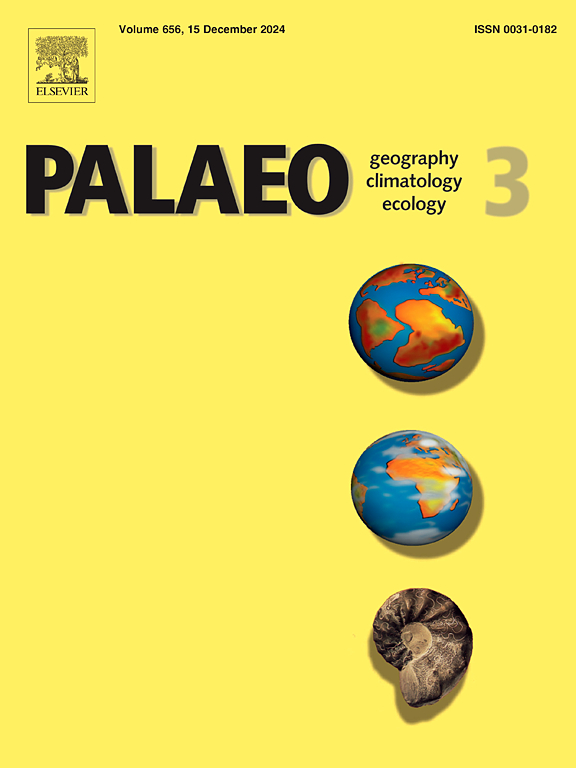南黄海HK-1井奥陶系综合地层及其年代学和古气候意义
IF 2.7
2区 地球科学
Q2 GEOGRAPHY, PHYSICAL
Palaeogeography, Palaeoclimatology, Palaeoecology
Pub Date : 2025-05-23
DOI:10.1016/j.palaeo.2025.113057
引用次数: 0
摘要
南黄海盆地位于下扬子克拉通东北缘,是一个重要的油气勘探远景区。然而,由于钻井资料不足,影响了对奥陶系地层的全面研究,而奥陶系地层是评价含油气系统特征的关键。HK-1钻孔标志着该地区首次接触到奥陶系地层,提供了重要的地层记录,增强了对早古生代构造、气候和环境演化的认识。本文研究了香港-1地区4083 ~ 4492 m奥陶系地层的碳同位素地层学和旋回地层学,建立了全球尺度上的地层对比关系。通过中达里廉到卡田的碳同位素转移已被确认,包括中达里廉同位素碳偏移(mice)和宝塔同位素碳偏移(PICE)。这些异常的识别和记录进一步加强了下扬子克拉通奥陶系演替的区域和全球对比。天文校正~ 11 m Th(钍)旋回到405kyr的轨道偏心旋回周期,将其他重要的、较短的沉积旋回与可识别为短轨道偏心(136 kyr和100 kyr)、倾角(32.4 kyr)和进动(18.4 kyr)的周期相一致。天文校准使用29个405-kyr偏心周期产生了一个~ 12 myr的浮动时间尺度,这表明HK-1钻孔最下层沉积物的推定年龄为~ 462.6 Ma。我们基于代理的研究还表明,在全球海平面上升期间,PICE与海洋缺氧有关。相反,在海平面下降期间,较轻的有机碳流入的增加可能干扰了mice。本文章由计算机程序翻译,如有差异,请以英文原文为准。
Ordovician integrative stratigraphy of the HK-1 Borehole in the South Yellow Sea and its geochronological and paleoclimatic implications
The South Yellow Sea Basin, situated at the northeastern margin of the Lower Yangtze Craton, represents a significant prospective area for hydrocarbon exploration. However, insufficient drilling data has impeded the comprehensive study of Ordovician strata, which are crucial for evaluating the characteristics of the petroleum system. The HK-1 Borehole marks the first encounter with Ordovician strata in this region, offering essential stratigraphic records that enhance the understanding of early Paleozoic tectonic, climatic, and environmental evolutions. In this study, carbon isotope stratigraphy and cyclostratigraphy from Ordovician strata at the depths of 4083 m to 4492 m in the HK-1 were studied to establish relationships for stratigraphic correlation on a global scale. Two carbon isotopic shifts through middle Darriwilian to Katian have been recognized, including Middle Darriwilian Isotopic Carbon Excursion (MDICE) and Pagoda Isotopic Carbon Excursion (PICE). The identification and documentation of these anomalies further reinforce both regional and global correlations within the Ordovician succession on the Lower Yangtze Craton. Astronomical calibration of ∼11 m Th (Thorium) cycles to 405-kyr orbital eccentricity cycle period aligns other significant, shorter sedimentary cycles to periods recognizable as short orbital eccentricity (136 kyr and 100 kyr), obliquity (32.4 kyr), and precession (18.4 kyr). Astronomical calibration produces an ∼12-Myr floating time scale using twenty-nine 405-kyr eccentricity cycles, which indicates a presumed age of ∼462.6 Ma for the lowermost sediments of HK-1 Borehole. Our proxy-based study also shows that the PICE was linked to marine anoxia during a global sea-level rise. In contrast, the increased influx of lighter organic carbon during sea-level regression may have disturbed the MDICE.
求助全文
通过发布文献求助,成功后即可免费获取论文全文。
去求助
来源期刊
CiteScore
5.90
自引率
10.00%
发文量
398
审稿时长
3.8 months
期刊介绍:
Palaeogeography, Palaeoclimatology, Palaeoecology is an international medium for the publication of high quality and multidisciplinary, original studies and comprehensive reviews in the field of palaeo-environmental geology. The journal aims at bringing together data with global implications from research in the many different disciplines involved in palaeo-environmental investigations.
By cutting across the boundaries of established sciences, it provides an interdisciplinary forum where issues of general interest can be discussed.

 求助内容:
求助内容: 应助结果提醒方式:
应助结果提醒方式:


